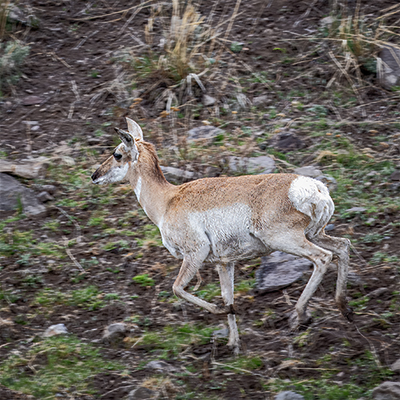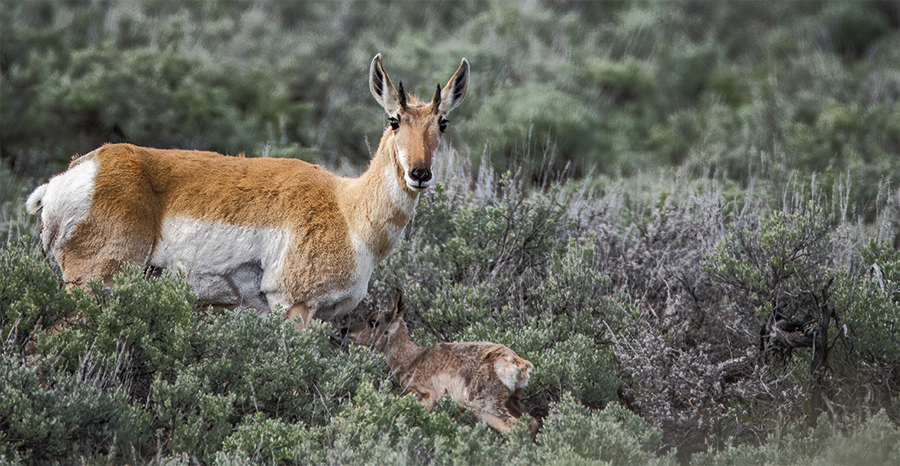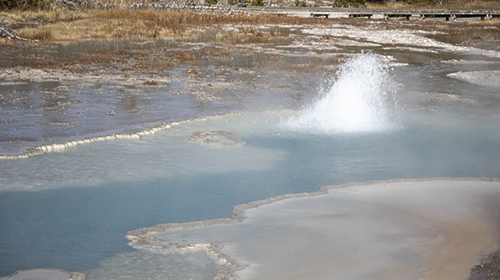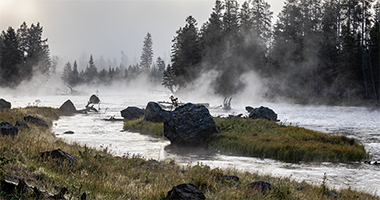Antelope, NO! I am a Pronghorn and proud of it.

There are no native antelopes in America. The animal found in North America's west is the pronghorn, which Americans have dubbed the American Antelope. The pronghorn is the last member of its biological family, but its population is growing. Wyoming and Yellowstone National Park are places where you can see these animals in their natural habitat.
The Antilocapra americana, pronghorn, is the fastest land animal in the Western Hemisphere and second fastest in the world to the cheetah.
Cheetahs can run 61-70 mph (98-112.7 kph) for only 30 seconds, or about 700 yards.
Pronghorns can run slightly slower at 50-60 mph (80.5-96.6 kph). The big difference is that they can cruise at 30 mph (48.3 kph) for over 20 miles. They can do sprints at 45-50 mph (72.4-80.5 kph) for short periods.
Newborns can walk within 30 minutes and outrun a human in a couple of days.
The question becomes, how do they run so fast? It starts with their anatomy; they are built to run. Their bone structure is extremely light. Their hair is hollow. Two long, cushioned, pointed toes act as shock absorbers. They have large windpipes, hearts, and lungs for air intake and circulation. While running, they run with their mouths open, which acts like an air scoop.


A female, doe, pronghorn can become pregnant at 16-17 months of age. Males are sexually mature at 1 year old but will not breed until 3-4 years old. The first pregnancy often results in a single fawn. Later pregnancies usually result in twin births. Fawns in Yellowstone are typically born in May or June. Newborns can walk at about 30 minutes post-delivery. They can outrun humans several days later.
Animals are amazing in their adaptations to life. The pronghorn has a musky scent. But newborns have little to no scent for the first week of life. This page's top and bottom pictures were taken about 30 minutes after one set of twins were born. The first twin delivered, bottom image, was walked about 100 yards away from the second born, above picture, where it will hide below the sagebrush. Mom will graze between the two, going to each one thrice daily to feed them. This adaptation protects the newborns from discovery by predators until they can move around better and faster.
Another way to identify male vs female pronghorns is to look for the black neck strip; those are the males. Look at the the picture on the right.
Looking at the horn, notice how the male's horn curls back to its rump at the top with a small prong on the front. Guess what? That is where the name pronghorn comes from.
Pronghorns are one of Yellowstone's seven native ungulates or hoofed animals.
The pronghorn's eyeballs are the largest of any North American ungulate. They are 1.4 inches (36 mm) in diameter. The way the eyes are in the skull gives the pronghorn a 300-degree arc of vision without moving its head. In contrast, humans have slightly over 210 degrees of vision without moving their heads. The pronghorn can see movement up to four miles away.
Pronghorns can jump fences, but they don't. They prefer to slide under them instead. Pronghorn fossil records go back 28 million years. European settlers didn't start settling the West and building fences until about the 1840s. Pronghorns have eons of history where they never had to jump things like fences; they will slide under fences instead.

Check out this page to learn more about the differences between horns and antlers and how pronghorn horns doesn't fit.
















